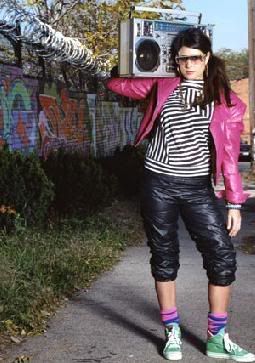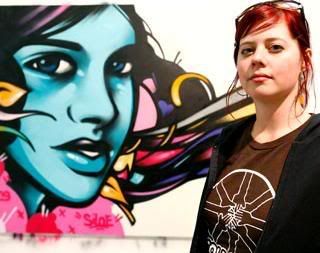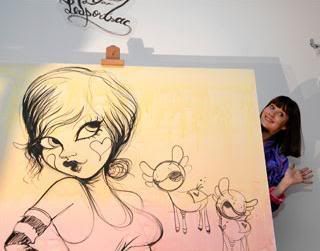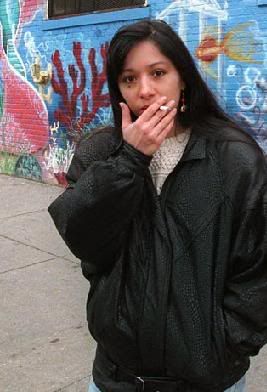Some say that graffiti has gone too mainstream, but one thing that's keeping the medium relevant is the growing influence of female artists. Introducing today's most influental female graffiti artists, who have changed the face of street art.
Claw
A New York native, Claw started bombing in the late eighties and continued to resurface during the nineties. Over the years, her signature symbol, a W-shaped, two-toned, three-taloned paw, has been seen in Amsterdam, Milan, and Los Angeles.

Siloette
Siloette hip-hop's influence in the graffiti world is indisputable, but for Phoenix native Siloette, it's the Smiths and not the Sugarhill Gang that play on her iPod when she hits the streets of Seattle, San Francisco, or L.A. With a spray can in her hand and Morrissey on her mind, she produces large-scale close-ups of strong, colorful female characters akin to Aubrey Beardsley illustrations in their long, flowing form and style. When she's not tagging, the 25-year-old utilizes other media such as pen and paper, acrylic paint on canvas, or even the occasional skateboard to create work for her eponymous design and printing company.Siloette with her design for the Adidas End-to-End Project.

Fafi
Thirty-one-year-old Fafi hails from Toulouse, a city in southern France with a thriving street-art scene that dates to the early nineties, when Miss Van, a female tagger who eschewed spray cans for acrylic paint and brushes, began creating erotic icons. Arriving on the scene a few years later, Fafi developed her own cast of sultry sexpots—flirtatious doll-like women with pouty lips, large almond-shaped eyes, and come-hither stares.

LadyPink
Lady Pink born in Ecuador and raised stateside, Lady Pink is widely considered to have been the first female graffiti artist on the New York City scene. "I focused on subway trains from about 1980 to 1985," says the prolific tagger.

Swoon
This five-foot-two South Florida native is a petite tour de force in street-art circles. After attending the Pratt Institute, where she studied classical painting, she became interested in what she calls "democratizing public spaces" with art. Her "paste-ups"—large-scale prints made by etching an outline into linoleum or wood and using a giant litho roller to apply the ink—can be seen everywhere from Bangkok to Brooklyn.

http://www.style.com
Claw
A New York native, Claw started bombing in the late eighties and continued to resurface during the nineties. Over the years, her signature symbol, a W-shaped, two-toned, three-taloned paw, has been seen in Amsterdam, Milan, and Los Angeles.

Siloette
Siloette hip-hop's influence in the graffiti world is indisputable, but for Phoenix native Siloette, it's the Smiths and not the Sugarhill Gang that play on her iPod when she hits the streets of Seattle, San Francisco, or L.A. With a spray can in her hand and Morrissey on her mind, she produces large-scale close-ups of strong, colorful female characters akin to Aubrey Beardsley illustrations in their long, flowing form and style. When she's not tagging, the 25-year-old utilizes other media such as pen and paper, acrylic paint on canvas, or even the occasional skateboard to create work for her eponymous design and printing company.Siloette with her design for the Adidas End-to-End Project.

Fafi
Thirty-one-year-old Fafi hails from Toulouse, a city in southern France with a thriving street-art scene that dates to the early nineties, when Miss Van, a female tagger who eschewed spray cans for acrylic paint and brushes, began creating erotic icons. Arriving on the scene a few years later, Fafi developed her own cast of sultry sexpots—flirtatious doll-like women with pouty lips, large almond-shaped eyes, and come-hither stares.

LadyPink
Lady Pink born in Ecuador and raised stateside, Lady Pink is widely considered to have been the first female graffiti artist on the New York City scene. "I focused on subway trains from about 1980 to 1985," says the prolific tagger.

Swoon
This five-foot-two South Florida native is a petite tour de force in street-art circles. After attending the Pratt Institute, where she studied classical painting, she became interested in what she calls "democratizing public spaces" with art. Her "paste-ups"—large-scale prints made by etching an outline into linoleum or wood and using a giant litho roller to apply the ink—can be seen everywhere from Bangkok to Brooklyn.

http://www.style.com
